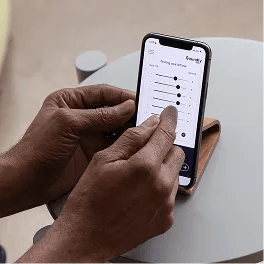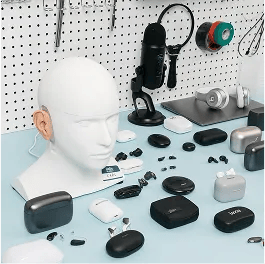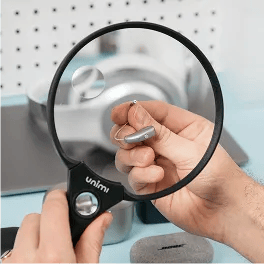As an audiologist with experience in diagnosing and treating hearing impairments, I've witnessed first-hand the challenges faced by those with severe hearing loss. It can be incredibly isolating, impacting every aspect of an individual's life—from personal relationships to professional opportunities. This is why I know it's essential that my patients find exactly the right technology to meet their unique needs.
I understand that each person's situation is different, requiring a thoughtful, personalized approach to their care.
This comprehensive guide focuses on CIC hearing aids for treating severe hearing loss. We'll begin with top products, followed by an in-depth exploration of the topic.
- Individuals with severe high frequency hearing loss can wear a CIC
- Individuals with flat, severe hearing loss will not be best fit with a CIC
- Dexterity and ear canal anatomy are also important to consider
- 50+ hearing aid brands reviewed and rated by our team of hearing aid wearers and audiologists
- 200+ hours each month spent researching brands and care options
- 2,000,000 people shopped on Soundly in 2024
- 100% independently owned and operated
Read more about our company, services and process here.
Featured in this article
Below are our top four CIC hearing aids for severe hearing loss. Each provides ample amplification and a custom-molded design to prevent feedback and other issues.
Phonak Virto Infinio
- Invisible-style or earbud style devices custom molded to your ear
- Advanced tech with noise cancelation and speech enhancement for clarity
- Optional titanium form factor for even sleeker and more durable design
If you’re a Phonak fan who prefers an in-ear device, Virto is a strong choice. Here’s why we picked it:
- Custom Fit: Each Virto is molded to fit your ear canal, providing exceptional comfort and invisibility.
- Enhanced Sound Quality: Equipped with SmartSpeech Technology, Virto adapts seamlessly with AutoSense OS to enhance speech clarity and reduce listening effort across different environments.
- Expert Support: Phonak has a broad network of local experts skilled with Virto, ensuring users receive knowledgeable care for the best results.
- Tiny sized invisible product
- Rechargeable and Bluetooth enabled half-shell product
- Fully customizable by your hearing professional
- Premium price point starting at $3,850
- Invisible style requires battery changes every 4-6 days
- Regardless of size, Phonak Virto Paradise hearing aids are fully customizable, prescription hearing aid appropriate for mild-profound hearing loss
- If you have profound hearing loss, you will want to select the largest Virto model which comes with an higher-powered speaker
- Phonak hearing aids are prescription devices fit and programmed by a professional
- To create your custom hearing aids, a professional will take earmold impressions in a clinic or in your home. They will then send those impressions to the Phonak manufacturing facility where a one-of-one replica will be created for your hearing aids
- After an initial fitting, you can connect the largest half or full-shell wireless models to the Phonak app to receive remote care
- Phonak Virto offers strong underlying sound algorithms consistent with Phonak's Paradise technology platform (Phonak now offers newer tech in their Lumity Receiver-in-Canal products).
- The largest Virto model includes directional microphones to manage complex environments
- Phonak Virto custom-molded devices sit comfortably in the ear. Some users with better hearing in lower frequencies prefer an open-fit behind-the-ear style hearing aid that allows more natural sound to pass into the ear canal
Learn more about the choice between in-the-ear vs. behind the ear styles here.
- Sit inside the ear
- Available sizes include Virto-P Titanium Battery Size 10, Virto-P Battery Size 10, Virto-P Battery Size 312 Non-Wireless, Virto-P Battery Size 312 Wireless
- Available Body colors: Blue, Brown, Pink, Red, Cocoa and Black,
- Available Faceplate colors: Black, Brown, Cocoa, Pink
Phonak Virto hearing aids only use disposable batteries
- Phonak offers Bluetooth enabled and non Bluetooth-enabled options with a size 312 battery (lasts 7-10 days)
- Phonak offers titanium and standard shell options with a size 10 battery (lasts 5-7 days)
- Virto Paradise half-shell and full-shell styles can be equipped with Bluetooth streaming
- Bluetooth models use Bluetooth classic connection and offer hands-free calling for iPhone and Android devices
- Telecoil is optional in all sizes but can not be selected alongside Bluetooth
- All sizes within the Phonak Virto Paradise family require regular disposable battery changes and good dexterity. The smallest sizes are especially difficult to manage due to their smaller size 10 battery.
- All sizes can include an optional push-button, three largest sizes can include an optional volume wheel
- The smallest models of Phonak Virto Paradise have an IP68 rating which means they can sustain 30 minutes of water exposure in up to one meter of water
- Larger 312 models do not include an IP rating
The larger wireless version of Virto Paradise has full access to the Phonak app. Smaller sizes do not have access to the smartphone app.
- Remote care: Available through the Phonak app in coordination with your provider
- Customization: Volume, treble/bass, adjustable custom programs in the app
- Tinnitus masking: Available through your healthcare provider
- Find my hearing aid: N/A
- Health tracking: Tracks length of wear time and step count
Oticon Own
- Custom-molded in-ear hearing aids, tailored for a discreet fit
- Options range from completely-in-canal styles to larger, rechargeable models
- Professionally programmed by a hearing care provider for a personalized setup
- Price range: $3,000 - $5,500 per pair, depending on features and size
For those who appreciate Oticon’s sound quality but prefer an in-ear option over a behind-the-ear format, Oticon Own offers a great alternative. Here’s why we chose it:
- Custom Fit: Each Oticon Own device is custom-molded for comfort and discretion, offering a tailored fit that blends seamlessly into your ear.
- In-Ear Streaming: Larger models support full Bluetooth streaming for both Android and iPhone, allowing you to enjoy phone calls, music, and other audio hands-free.
- Proven Sound Processing: Powered by Oticon’s 2022 sound system, previously used in Oticon Real, Oticon Own brings advanced noise handling and clarity into a small, in-ear design—ideal for users who want powerful hearing support without the bulk of traditional hearing aids.
- Oticon Own hearing aids are designed for mild to severe hearing loss, making them a versatile option for many users.
- They are available in IIC and CIC sizes, which are discreet and comfortable to wear.
- They include an optional push button or volume wheel, as well as binaural connection between hearing aids to improve directionality, giving users more control over their hearing aids.
- ITC and Full-Shell sizes allow for Bluetooth connection and telehealth programming after an initial appointment.
- Oticon Own hearing aids are only available through prescription channels, so you'll need to purchase them locally instead of over-the-counter or through telehealth.
- They are a premium-priced product, which may not be affordable for all users.
- Oticon Own does not offer a rechargeable option.
- Regardless of size, Oticon Own hearing aids are fully customizable, prescription hearing aid appropriate for mild-severe hearing loss
- If you have profound hearing loss, you may be a better fit for Oticon's Xceed hearing aids
- Oticon Own hearing aids are prescription devices fit and programmed by a professional
- To create your custom hearing aids, a professional will take earmold impressions in a clinic or in your home. They will then send those impressions to the Oticon manufacturing facility where a one-of-one replica will be created for your hearing aids
- After an initial fitting, you can connect with your care provider remotely through the Oticon Companion app
- Own uses Oticon's deep neural network to sort background noise from speech. Many users describe Oticon's sound quality as "relaxed", "natural" and "comfortable."
- Oticon Own custom-molded devices sit comfortably in the ear. Some users with better hearing in lower frequencies prefer an open-fit behind-the-ear style hearing aid that allows more natural sound to pass into the ear canal.
Learn more about the choice between in-the-ear vs. behind the ear styles here.
- Sit inside the ear
- Available sizes include full-shell, half-shell, in-the-canal (ITC), completely-in-the-canal (CIC), invisible-in-canal (IIC)
- Oticon offers 5 colors including black, beige, light brown, medium brown and dark brown
Oticon Own hearing aids all use disposable batteries
- Full-shell (FS), half-shell (HS), and In-The-Canal (ITC) models use a 312 battery (lasts 7-10 days)
- Completely-in-canal (CIC), and Invisible-In-Canal (IIC) models use a size 10 battery (lasts 5-7 days)
- Oticon Own offers Bluetooth streaming or Telecoil in the three largest styles (FS, HS and ITC)
- Smaller models (CIC and IIC) do not allow Bluetooth streaming or Telecoil
- iPhone users can take calls hands-free, while Android users must keep their phones close to pick up outbound audio
- Oticon Real devices use Apple's MFI connection and Android's ASHA connection to stream content through Bluetooth
- All sizes and styles within the Oticon Own family require regular disposable battery changes and good dexterity. The smallest two sizes (CIC and IIC) are especially difficult to manage due to their smaller size 10 battery.
- Oticon Own hearing aids are water resistant with an IP rating of 68
- This hearing aid can withstand dust and water submersion in one meter of water for up to 30 minutes
- Remote care: included in the new Oticon Companion app
- Customization: volume, program change, streaming sound quality (treble/bass), SpeechBooster
- Tinnitus masking: your hearing care provider can create a tinnitus masking program
- Find my hearing aid: available in the app
- Health tracking: not available
Note that Oticon Own CIC and IIC sizes do not come with connection to the Oticon Companion app.
Signia Silk
- Virtually invisible fit, fully inside the ear canal
- Smallest rechargeable prescription hearing aid with all-day battery and portable charger
- Dual processors for clear speech in noisy settings, with natural Own Voice Processing (OVP)
- Ready-to-wear with pre-sized click sleeves, no custom molds needed
Signia Silk stands out for its near-invisibility and comfort, offering a discreet in-the-ear design that fits entirely within the ear canal. Here’s why we picked it:
- Invisible Comfort: Signia Silk is one of the smallest in-the-ear hearing aids, making it practically invisible to others.
- Rechargeable Power: It’s the tiniest rechargeable option, giving a full day’s use and coming with a portable charging case for quick and easy recharges on the go.
- Advanced Sound Processing: With dual processors, Signia Silk provides clear speech in noisy environments, while Own Voice Processing (OVP) minimizes the volume of your voice, creating a more natural hearing experience.
- No Custom Molds Needed: Designed for convenience, it’s ready-to-wear with pre-sized click sleeves, skipping the need for custom molds and simplifying fittings.
Users appreciate the discreet design, clear sound quality, and rechargeable batteries. However, some are concerned about the lack of onboard buttons and lack of Bluetooth streaming. Here are a few sample reviews from our partners at Zip Hearing.
- "I have been able to hear sounds I have not heard before. Concerned about the on/off situation. The charging is great, no battery to change." - Tom
- "These Signia Silk Charge&Go hearing aids are miraculous: they are hidden in your ear and basically invisible, but rechargeable, adjustable via the app on your mobile phone and they deliver great quality sound-even in noisy places like restaurants. And no fitting it’s required because they come with multiple size rubber ear pieces, so they’re good to go on your first audiologist visit. Dazzling!" - Allen
- "I'm really impressed with my Signia Silk Charge and Go 7IX. WIth the right provider, I now find them comfortable to wear all day and the difference in my hearing acuity before and after, is amazing. The unfortunate trade off, between supper small CIC's and no blue tooth (that's why I gave them a 4.5), for me, is acceptable." - Jean
- Nearly invisible Professionally programmed
- No custom-mold required
- Rechargeable batteries
- Premium price point $2,998 - $5,000 for a pair
- Requires an in person office visit
- No Bluetooth features due to the size
- No onboard buttons (requires app or remote control)
- Signia Silk hearing aids are appropriate for mild-severe hearing loss
- Silk devices are not custom-molded and may create feedback in some severe cases
- If you have profound hearing loss, you may be a better fit for high-powered BTE hearing aids (not currently offered by Signia)
- Signia hearing aids are prescription devices fit and programmed by a professional
- Unlike other leading in-the-ear style devices, Signia Silk does not require a custom-earmold. Instead the device comes with a range of Click Sleeves that fit a wide range of ears
- After an initial fitting, you can connect with your care provider remotely through the Signia app for fine-tuning and program changes
- Signia uses a unique Split Processing technique helps isolate background noise and boost speech clarity
- Signia's Own Voice Processing (OVP) helps take the edge off of that uncomfortable sound quality of the user's own voice that many patients experience when adjusting to hearing aids
- Signia Silk hearing aids are slightly less comfortable than custom-molded alternatives
- Sit inside the ear
- Only available in one completely-in-canal size (nearly invisible in many ears)
- Choose from two faceplate colors: Black and Mocha
- Signia Silk hearing aids use disposable size 10 batteries (lasts 5-7 days)
- Signia Silk does not come with Bluetooth streaming
- Signia Silk requires regular disposable battery changes and good dexterity.
- Signia Silk hearing aids are not advertised as water resistant. Keep these devices away from water when possible.
- Remote care: Included in the Signia app (not a separate app)
- Customization: Treble/bass, volume, microphone directionality, Signia Assistant
- Tinnitus masking: Customizable options through your hearing care professional
- Find my hearing aid: Not available
- Health tracking: Step tracking, activity (e.g., high intensity versus low), and wear time
Starkey Signature Series
- Latest custom hearing aid line from Starkey, a leader in custom styles
- Made in the U.S. with options from fully invisible to larger rechargeable models
- Powered by Starkey’s AI-enabled Neuro processor for enhanced background noise management
Starkey's Signature Series leverages a long history in custom hearing aids, even trusted by President Ronald Reagan in the 1980s. Here’s why it stands out:
- Custom Fit: Each Signature Series device is crafted to each user’s ear from an in-clinic ear impression, providing unmatched comfort and discreetness.
- Versatile Styles: From a nearly invisible-in-the-canal (IIC) model to a larger rechargeable style with up to 38 hours of power and IP68 water resistance, the Signature Series offers flexibility to suit different needs.
- American-Made Quality: Starkey is the only major hearing aid manufacturer based in the U.S., combining local innovation with decades of expertise.
Starkey’s commitment to personalized, high-quality hearing solutions has made it a trusted name for generations.
- Smallest models are almost entirely invisible
- Starkey is a leader in comfortable custom molded products
- Larger sizes come with Bluetooth rechargeable batteries
- This is a premium device which costs $3,000-$7,000 per pair
- Custom molds require additional lead time and replacement time
- The smallest version of Starkey Genesis AI customs are not rechargeable
- None of the Signature Series devices are Bluetooth enabled
- Regardless of size, Starkey Genesis AI hearing aids are fully customizable, prescription hearing aid appropriate for mild-severe hearing loss
- If you have profound hearing loss, you may be a better fit for Starkey's BTE-style hearing aids
- Starkey Genesis AI hearing aids are prescription devices fit and programmed by a professional
- To create your custom hearing aids, a professional will take earmold impressions in a clinic or in your home. They will then send those impressions to the Starkey manufacturing facility where a one-of-one replica will be created for your hearing aids
- After an initial fitting, you can connect with your care provider remotely through the Starkey app
- Starkey Genesis AI hearing aids come with robust background noise management features including Starkey's deep neural network that makes up to 80M adjustments per hour to match your environment
- Genesis AI custom-molded devices sit comfortably in the ear. Some users with better hearing in lower frequencies prefer an open-fit behind-the-ear style hearing aid that allows more natural sound to pass into the ear canal.
Learn more about the choice between in-the-ear vs. behind the ear styles here.
- Sit inside the ear
- Available sizes include full-shell, half-shell, completely-in-the-canal, invisible-in-canal
- Starkey offers 5 colors including black, pink, light brown, medium brown and dark brown
- Starkey's IIC style is on our list of the best invisible hearing aids available
- Starkey's half-shell and full-shell models are rechargeable with up to 36 hours of battery life
- Starkey's completely-in-canal and invisible-in-canal models use a size 10 disposable battery (lasts 5-7 days)
- Genesis AI offers Bluetooth streaming in full-shell and half-shell models
- Genesis AI does not offer Bluetooth streaming for completely-in-canal (CIC) or invisible-in-canal (IIC) models
- iPhone users can take calls hands-free, while Android users must keep their phones close to pick up outbound audio.
- Genesis AI devices use Apple's MFI connection and Android's ASHA connection to stream content through Bluetooth
The larger, rechargeable models of Genesis AI custom-molded hearing aids are reasonably easy to handle, while the smaller, disposable battery-powered models require more dexterity.
- All models have a single piece that sits in the ear vs. RIC styles with a piece in and behind the ear
- Larger sizes include a push button, while smaller sizes do not
- Rechargeable models use port charging vs. conduction charging (slightly more challenging to handle)
- The smallest sizes require regular battery changes (requires good dexterity)
- Starkey Genesis AI are water resistant with an IP rating of 68
- This hearing aid can withstand dust and water submersion in one meter of water for up to 30 minutes
- Remote care: available through the app with care provider coordination
- Customization: Edge Mode and adjustments in the app
- Tinnitus masking: programs can be created by your hearing healthcare provider
- Find my hearing aid: yes
- Health tracking: activity tracking
Note that Starkey's CIC and IIC sizes do not come with connection to the Starkey app.
Severe Hearing Loss - What does it mean?
Severe hearing loss is not one-size-fits-all. It can vary significantly from one individual to another, and understanding the nuances is crucial in providing effective care. If you discover that your hearing loss is severe, you might be wondering what that means.
For many, severe high-frequency hearing loss is the challenge, wherein they find it particularly difficult to hear high-pitched sounds like women's or children's voices, the turn signal in the car, or understand speech clearly, yet they may retain better hearing in the lower frequencies.
So while they may hear soft sounds in their environment (i.e., a refrigerator humming or thunder rumbling), speech clarity remains elusive. You hear people talking but can't understand what they're saying. This type of an audiogram could like something like this:
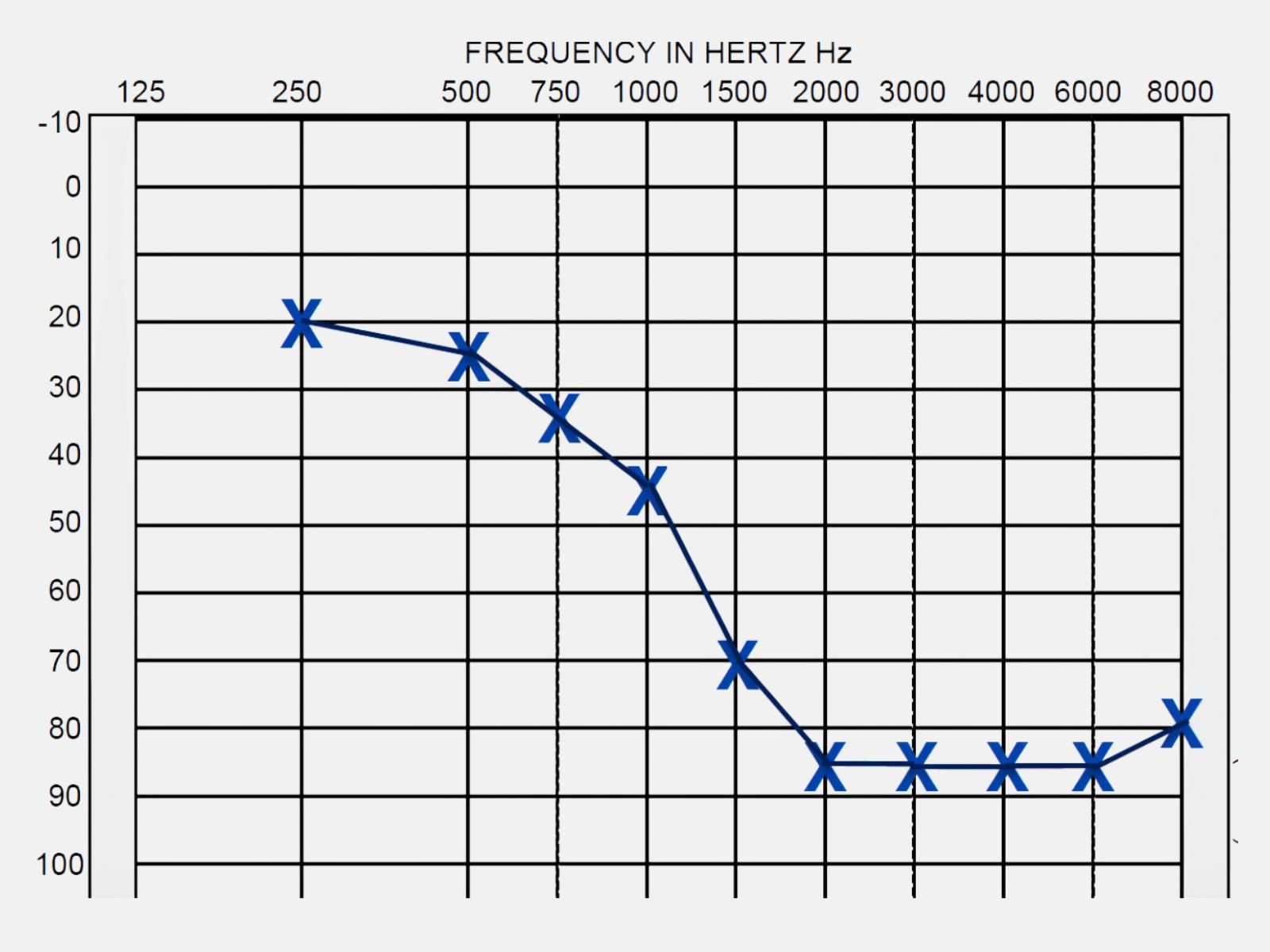
The right treatment approach will focus on balancing the amplification across different frequencies: a solid boost of the high frequencies but not too much low frequency sound.
Others with severe hearing loss may have a flat, severe hearing loss, characterized by relatively equal reduction in hearing ability across all frequencies. This type of hearing loss requires a more uniform amplification strategy, ensuring that all sounds are amplified appropriately. However, there still needs to be a balance between audibility and comfort (i.e., keeping sound audible but not to the point of discomfort). Here's an example of a flat, severe audiogram:
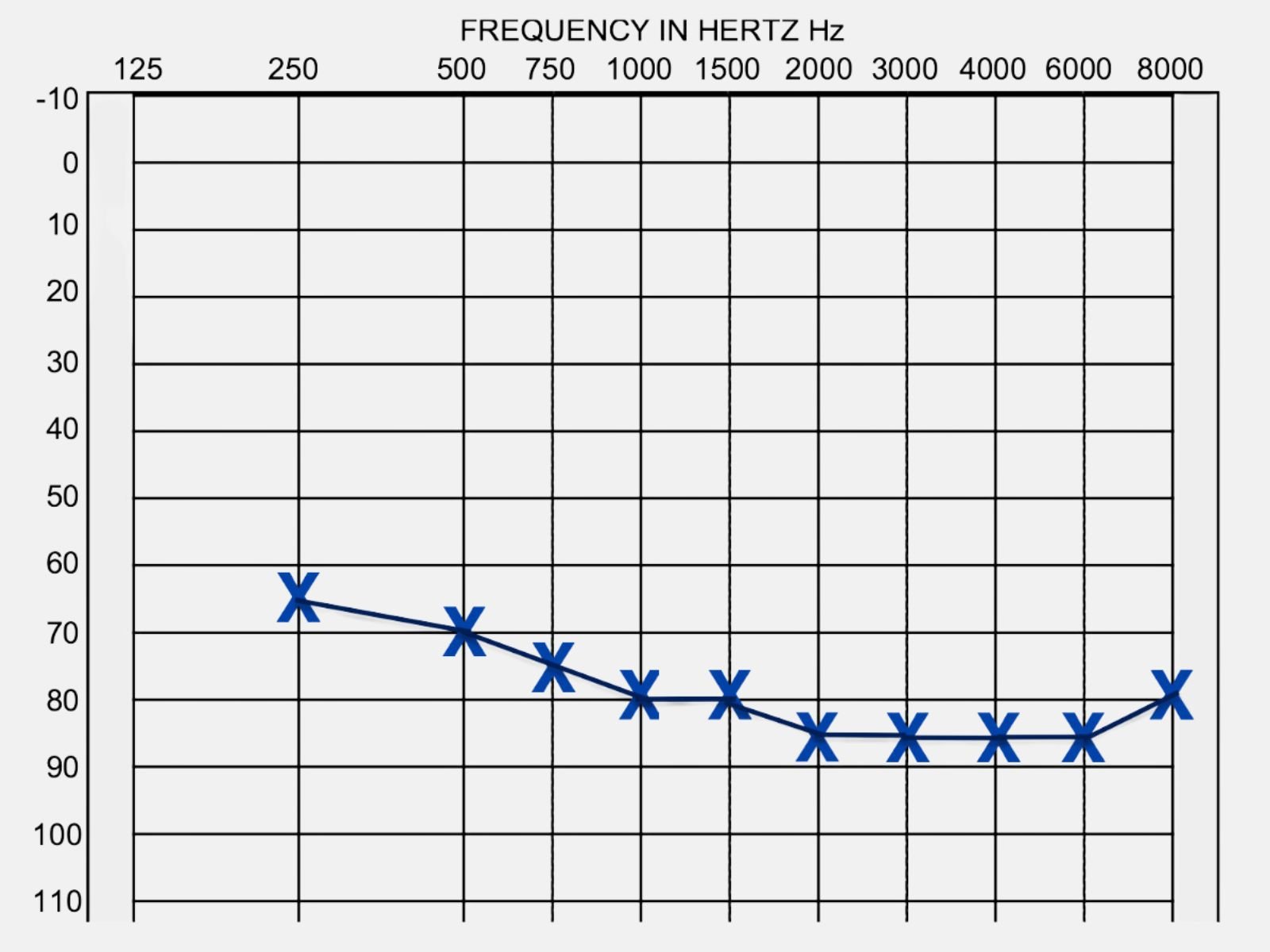
As you can see, each of these situations requires a different strategy for the optimal outcome.
Selecting the Right Care Model
For individuals with severe hearing loss, choosing the right care model is paramount. You may have come across over-the-counter (OTC) hearing aids in your search for hearing solutions. It's important to understand that these devices are designed for individuals with mild to moderate hearing loss.
This means that if your hearing loss is categorized as severe, OTC hearing aids will not provide the level of support you need. In such cases, it's crucial to opt for a more personalized care approach.
Two primary models offer the personalized care necessary for severe hearing loss: in-person care and Telehealth services. In-person care involves direct, face-to-face consultation with an audiologist or hearing specialist. This model allows for an in-depth hearing assessment, tailored fitting sessions, and hands-on support through the adjustment period.
On the other hand, Telehealth services have emerged as a viable alternative, especially for those who may have difficulty accessing in-person care due to location or mobility issues. Telehealth involves remote consultation and support, leveraging technology to provide high-quality care.
Regardless of which model you choose, the goal is to ensure that your hearing aids are properly fitted and tailored to your specific hearing loss profile. A hearing healthcare provider will help you understand your audiogram, select the right hearing aid model, and adjust it to your comfort and needs.
Severe Hearing Loss Demands Precision
Severe hearing loss demands precision in treatment and technology. So, when it comes to selecting a hearing aid for severe hearing loss, what should you look for? Fortunately, technology today allows for a lot of flexibility to fit everyone's needs.
Before we jump into the specific types of hearing aids, it's essential to consider all aspects of your lifestyle and how your hearing aid can accommodate that. For instance, if dexterity is a concern due to arthritis or other reasons, you might want to consider a rechargeable device. These types of hearing aids eliminate the need for changing tiny hearing aid batteries, making your life a bit easier.
Furthermore, for those who want to stream audio from their hearing aids, selecting a device with Bluetooth capability is crucial. This feature allows you to stream audio directly from your phone right into your hearing aids, transforming them into a pair of high-quality, wireless earphones. This not only improves audibility for your calls but also integrates seamlessly with your day-to-day activities, ensuring you don't miss a beat.
Is a CIC a good option for severe hearing loss?
So you've got severe hearing loss and are thinking about a discrete hearing aid. Completely-in-Canal (CIC) hearing aids are renown for their nearly invisible and custom-fit designs, but they are a few caveats when selecting this style hearing aid. Let's go through a few points when considering this option:
- hearing loss profile
- anatomy
- ear "real estate"
- dexterity
Hearing Loss Profile
When it comes to matching hearing aids with individual hearing loss profiles, it's crucial to understand that not every style fits every type of hearing loss. Specifically, while a Completely-in-Canal (CIC) hearing aid can often accommodate individuals with severe high-frequency hearing loss, those with a flat, severe hearing loss may find this style less effective. The intricacies of severe high-frequency hearing loss mean that while the lower frequencies remain more intact, it's the high frequencies that need amplification. CIC hearing aids, with their placement deep within the ear canal, can leverage the ear's natural shape to enhance sound directionality and clarity, particularly in the high frequencies.
On the other hand, a flat severe hearing loss, characterized by a uniform reduction across all frequencies, presents a different challenge. The main limitation with CIC aids in this context is their size and power capabilities.
Due to their compact size, fitting the broader range of frequencies with the necessary amplification power may not be feasible without sacrificing sound quality or comfort. In such cases, other styles of hearing aids, which can house more powerful amplifiers and larger batteries, might be more suitable to ensure a balanced and effective hearing improvement across all frequencies.
Thus, understanding your specific hearing loss profile is an indispensable step in selecting a hearing aid that not only fits well but also meets your auditory needs comprehensively.
Anatomy
Anatomy is an important factor to consider when selecting a Completely-in-Canal (CIC) hearing aid. Given their design to fit snugly within the ear canal, the right ear canal size and shape are crucial for a proper fit. Most CIC hearing aids are made from a deep ear impression, and an audiologist will evaluate your ear canal during an in-person visit.
This means that if your ear canal is extremely narrow or has a shape that doesn't accommodate the typical dimensions of a CIC hearing aid, this style might not be suitable for you. An improper fit can not only be uncomfortable but can also affect the performance of the hearing aid, impacting its effectiveness in amplifying sound.
Independent of hearing loss severity, everyone’s ear canal has a different size and shape. Therefore, a thorough examination of your ear canal by a healthcare professional is an essential step in the process of selecting a hearing aid, ensuring that the device you choose is perfectly tailored to your unique anatomical structure.
Ear "Real Estate"
The concept of "ear real estate," or the space available around and behind the ear, presents another compelling rationale for considering a Completely-in-Canal (CIC) hearing aid, especially in the era of Covid-19. During the pandemic, when wearing masks became a ubiquitous necessity, many individuals discovered the practicality of custom, in-canal hearing aids.
This was particularly true for those who also wear glasses or use oxygen masks, where the reduced space behind the ear makes traditional behind-the-ear hearing aids less feasible. Furthermore, individuals with petite ears may find that CIC hearing aids offer a more comfortable and secure fit, avoiding the overcrowding and discomfort that can occur with larger devices.
In these cases, the minimalistic footprint of CIC models can enhance both physical comfort and device usability, providing a compelling option for those prioritizing discreetness and convenience alongside auditory improvement.
Dexterity Considerations
Finally, dexterity is an important consideration when selecting the right hearing aid for individuals with severe hearing loss. If you have trouble manipulating small devices due to conditions such as arthritis, neuropathy, or just general difficulty with fine motor skills, you may want to opt for a larger custom hearing aid.
A rechargeable In-the-Ear (ITE) model is a viable option that tends to be a bit easier to manage. These devices not only reduce the need for handling small batteries – a task that can be frustrating and challenging – but also offer the convenience of not having to replace batteries frequently.
The physical design of ITE hearing aids, being slightly larger and easier to grasp, allows for better handling and overall management of the device. This feature, coupled with the fact that rechargeable models can be placed in a charging dock overnight for hassle-free use throughout the day, makes them an excellent choice for those prioritizing ease of use alongside effective hearing support.
Final Thoughts
Selecting the right hearing aid, especially for those with severe hearing loss, is a nuanced decision that demands a comprehensive understanding of one's own hearing loss profile, lifestyle needs, and personal preferences.
Completely-in-Canal (CIC) hearing aids, known for their discreet design and advanced technological features, offer substantial benefits for individuals with severe high-frequency hearing loss. However, it's equally vital to acknowledge that no single style suits every type of hearing impairment.
Factors such as the nature of the hearing loss, power and amplification needs, as well as personal dexterity in handling the devices, play a pivotal role in determining the best fit. Our exploration through notable CIC models underscores the diversity and advancements in hearing aid technology, aiming to empower individuals with the knowledge and options to enhance their auditory experience effectively.
Through careful consideration and possibly consultation with audiology professionals, one can find a hearing aid that not only meets their hearing needs but also fits seamlessly into their lifestyle, thereby improving overall quality of life.

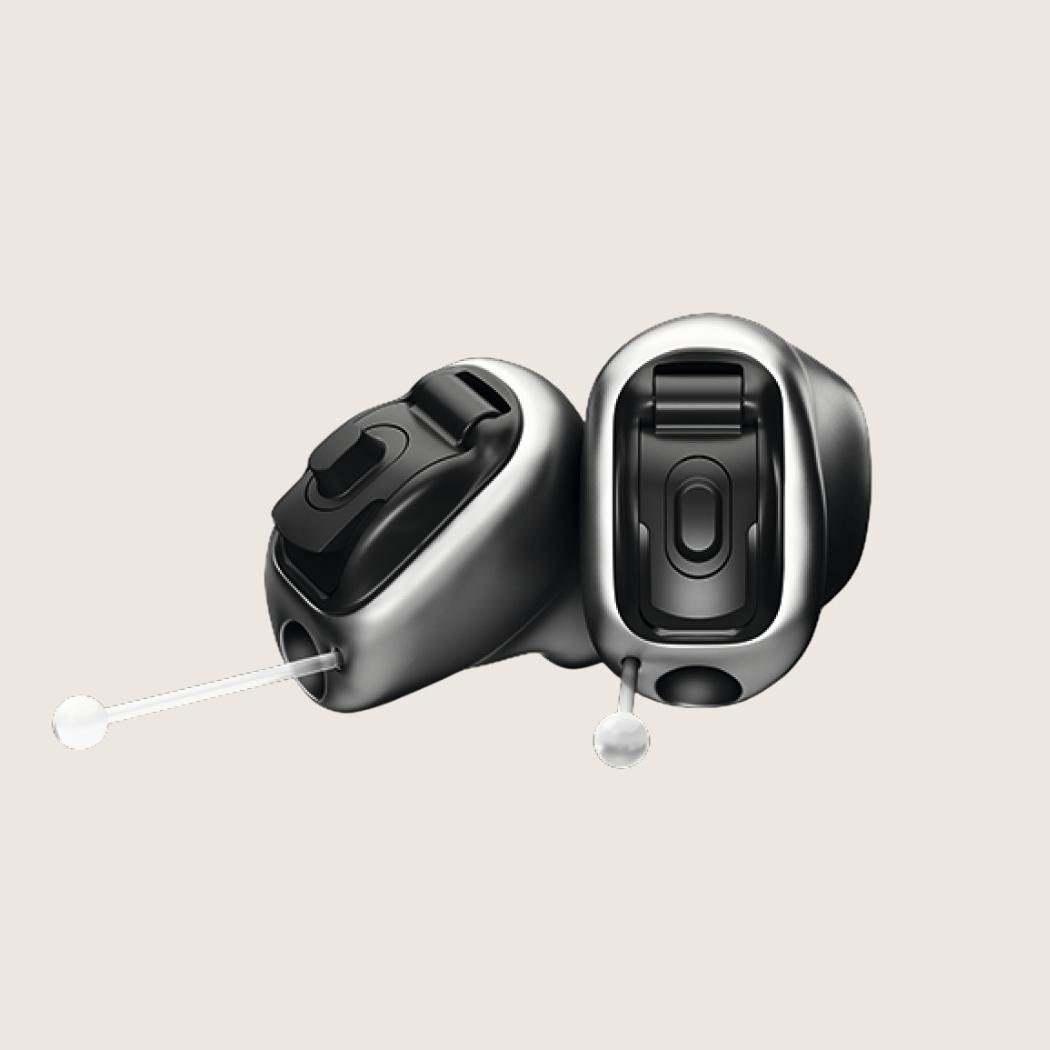

.jpg)
